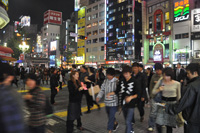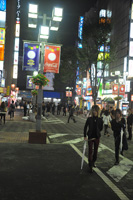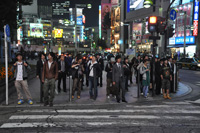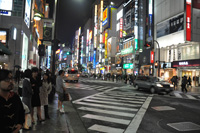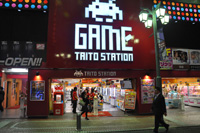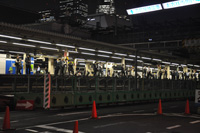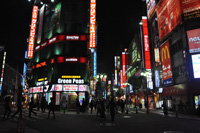 A major commercial and administrative center housing the Tokyo Metropolitan Government Building, Shinjuku is one of the 23 special wards of Tokyo. As of 2008, the ward had an estimated population of 312,418 and a density of 17,140 persons per km. The total area is 18.23 km.
As of October 1, 2005, 29,353 non-Japanese with 107 different nationalities were registered in Shinjuku. Shinjuku is a major urban transit hub. JR Shinjuku Station sees an estimated 3.64 million passengers pass through each day, making it the busiest station in the world. It houses interchanges to three subway lines and three privately owned commuter lines, as well as several JR lines.
A major commercial and administrative center housing the Tokyo Metropolitan Government Building, Shinjuku is one of the 23 special wards of Tokyo. As of 2008, the ward had an estimated population of 312,418 and a density of 17,140 persons per km. The total area is 18.23 km.
As of October 1, 2005, 29,353 non-Japanese with 107 different nationalities were registered in Shinjuku. Shinjuku is a major urban transit hub. JR Shinjuku Station sees an estimated 3.64 million passengers pass through each day, making it the busiest station in the world. It houses interchanges to three subway lines and three privately owned commuter lines, as well as several JR lines.
 In 1634, during the Edo period, as the outer moat of the Edo Castle was built, a number of temples and shrines moved to the Yotsuya area on the western edge of Shinjuku. In 1698, Naitō Shinjuku had developed as a new (shin) station (shuku or juku) on the Kōshū Kaidō, one of the major highways of that era. Naitō was a daimyo whose mansion stood in the area; his land is now a public park, the Shinjuku Gyoen.
In 1920, the town of Naitō-Shinjuku that comprised large parts of present-day Shinjuku, parts of Nishi-Shinjuku and Kabukichō was integrated into Tokyo City. Shinjuku began to develop into its current form after the Great Kantō earthquake in 1923, since the seismically stable area largely escaped the devastation. Consequently, West Shinjuku is one of the few areas in Tokyo with many skyscrapers.
In 1634, during the Edo period, as the outer moat of the Edo Castle was built, a number of temples and shrines moved to the Yotsuya area on the western edge of Shinjuku. In 1698, Naitō Shinjuku had developed as a new (shin) station (shuku or juku) on the Kōshū Kaidō, one of the major highways of that era. Naitō was a daimyo whose mansion stood in the area; his land is now a public park, the Shinjuku Gyoen.
In 1920, the town of Naitō-Shinjuku that comprised large parts of present-day Shinjuku, parts of Nishi-Shinjuku and Kabukichō was integrated into Tokyo City. Shinjuku began to develop into its current form after the Great Kantō earthquake in 1923, since the seismically stable area largely escaped the devastation. Consequently, West Shinjuku is one of the few areas in Tokyo with many skyscrapers.
 The Tokyo air raids from May to August 1945 destroyed almost 90% of the buildings in the area in and around Shinjuku Station. The pre-war form of Shinjuku, and the rest of Tokyo, for that matter, was retained after the war because the roads and rails, damaged as they were, remained, and these formed the heart of Shinjuku in the post-war construction. Only in Kabuki-cho was a grand reconstruction plan put into action.
The present ward was established on March 15, 1947 with the merger of the former wards of Yotsuya, Ushigome, and Yodobashi. It served as part of the athletics 50 km walk and marathon course during the 1964 Summer Olympics.
In 1991, the Tokyo Metropolitan Government moved from the Marunouchi district of Chiyoda to the current building in Shinjuku.
The Tokyo air raids from May to August 1945 destroyed almost 90% of the buildings in the area in and around Shinjuku Station. The pre-war form of Shinjuku, and the rest of Tokyo, for that matter, was retained after the war because the roads and rails, damaged as they were, remained, and these formed the heart of Shinjuku in the post-war construction. Only in Kabuki-cho was a grand reconstruction plan put into action.
The present ward was established on March 15, 1947 with the merger of the former wards of Yotsuya, Ushigome, and Yodobashi. It served as part of the athletics 50 km walk and marathon course during the 1964 Summer Olympics.
In 1991, the Tokyo Metropolitan Government moved from the Marunouchi district of Chiyoda to the current building in Shinjuku.
Shinjuku has the largest concentration of skyscrapers in Tokyo and is a major commercial center, but certainly not the only one in Tokyo. All manner of entertainment is available, and there are neighborhoods in this part of the city where prostitution is openly tolerated if not completely legal. From the time you exit the train station there is a constant solicitation, but it is easily ignored. Unlike in the US, what we might consider a seedier side of Tokyo is still clean, orderly, and in its own way respectable. There was never a time in Japan where I felt unsafe. Violent crime is rare, so walking around at night wasn't an issue anywhere in Japan. If you like to people watch Shinjuku is the best place. I sat on a bench outside Shinjuku Station my last two nights in Tokyo and watched the biggest throng of people walk by.
You would not call this envoronment secular or pluralistic, as if to suggest some sort of converse from the norm.
